Customer Loyalty and Marketing Communication Mix for Central Group
VerifiedAdded on 2023/01/03
|82
|18919
|82
Thesis and Dissertation
AI Summary
This dissertation examines the creation of customer loyalty through the strategic use of the marketing communication mix, with a specific focus on the Central Group brand in Thailand. The research investigates the critical role of customers in business success and the importance of attracting and retaining them through effective marketing strategies. The study addresses the challenges associated with advertising, direct marketing, discounts, and promotions, and maintaining a consistent brand presence. The methodology includes a positivism research philosophy, a deductive research approach, and a descriptive research design, utilizing a random non-probability sampling technique with 50 employees of Central Group. The findings reveal the significance of the marketing communication mix in fostering customer loyalty, while also acknowledging challenges. The dissertation explores the challenges and advantages of marketing mix in the current scenario of Thailand and provides recommendations to enhance customer loyalty for the Central Group, analyzing factors influencing customer behavior and the effectiveness of various marketing communication tools such as advertising, sales promotion, public relations, and direct marketing. The dissertation concludes with recommendations for improving customer loyalty for Central Group, and suggestions for future research in this area.
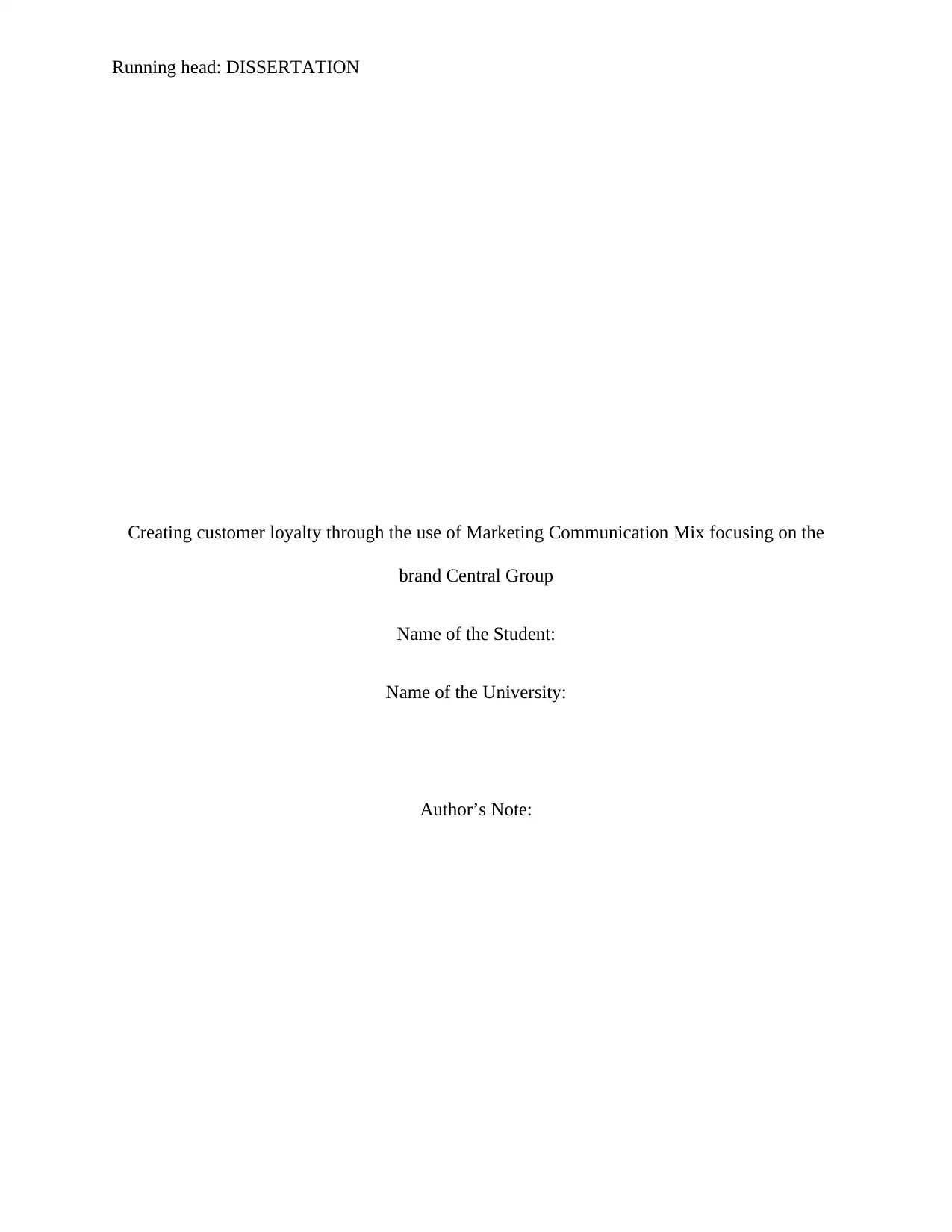
Running head: DISSERTATION
Creating customer loyalty through the use of Marketing Communication Mix focusing on the
brand Central Group
Name of the Student:
Name of the University:
Author’s Note:
Creating customer loyalty through the use of Marketing Communication Mix focusing on the
brand Central Group
Name of the Student:
Name of the University:
Author’s Note:
Paraphrase This Document
Need a fresh take? Get an instant paraphrase of this document with our AI Paraphraser
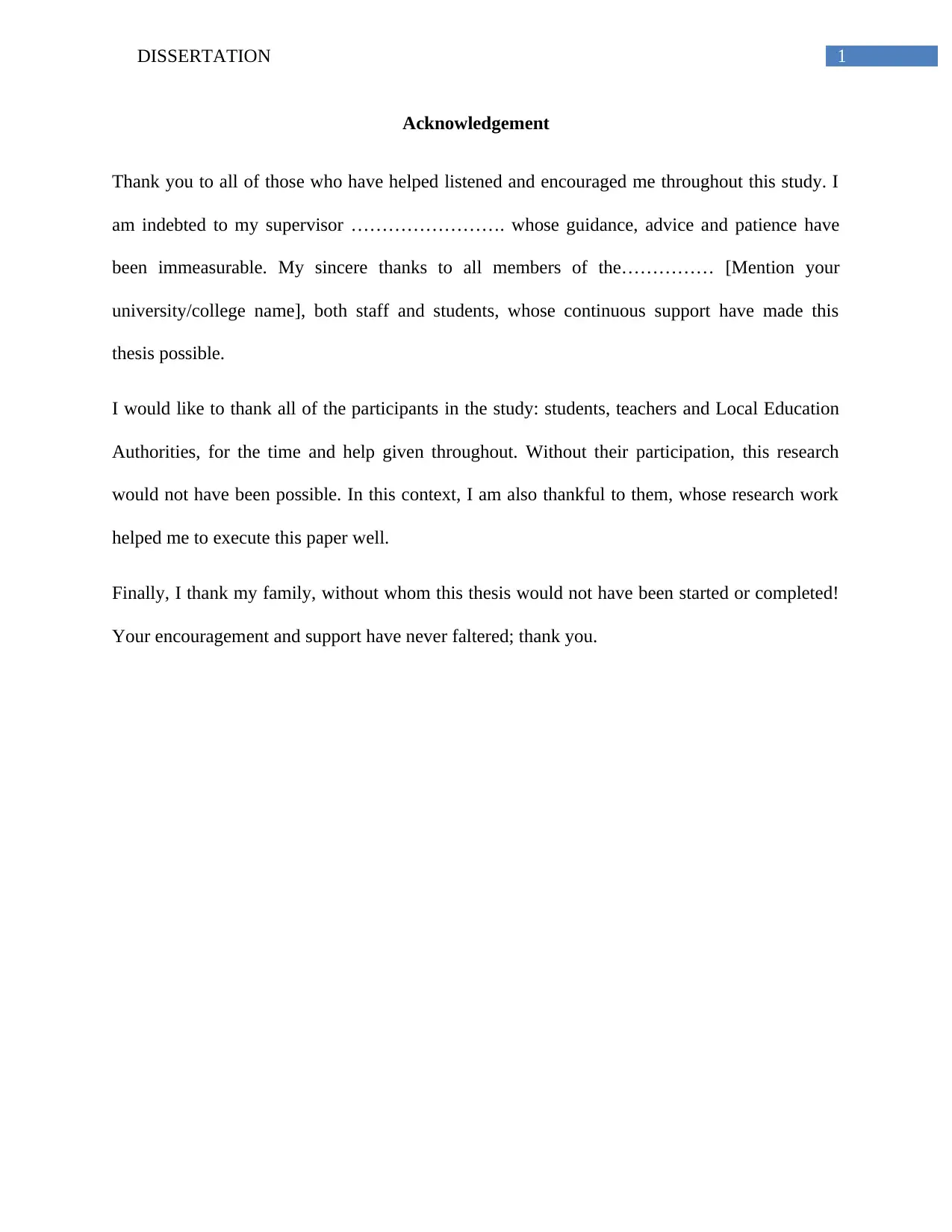
1DISSERTATION
Acknowledgement
Thank you to all of those who have helped listened and encouraged me throughout this study. I
am indebted to my supervisor ……………………. whose guidance, advice and patience have
been immeasurable. My sincere thanks to all members of the…………… [Mention your
university/college name], both staff and students, whose continuous support have made this
thesis possible.
I would like to thank all of the participants in the study: students, teachers and Local Education
Authorities, for the time and help given throughout. Without their participation, this research
would not have been possible. In this context, I am also thankful to them, whose research work
helped me to execute this paper well.
Finally, I thank my family, without whom this thesis would not have been started or completed!
Your encouragement and support have never faltered; thank you.
Acknowledgement
Thank you to all of those who have helped listened and encouraged me throughout this study. I
am indebted to my supervisor ……………………. whose guidance, advice and patience have
been immeasurable. My sincere thanks to all members of the…………… [Mention your
university/college name], both staff and students, whose continuous support have made this
thesis possible.
I would like to thank all of the participants in the study: students, teachers and Local Education
Authorities, for the time and help given throughout. Without their participation, this research
would not have been possible. In this context, I am also thankful to them, whose research work
helped me to execute this paper well.
Finally, I thank my family, without whom this thesis would not have been started or completed!
Your encouragement and support have never faltered; thank you.
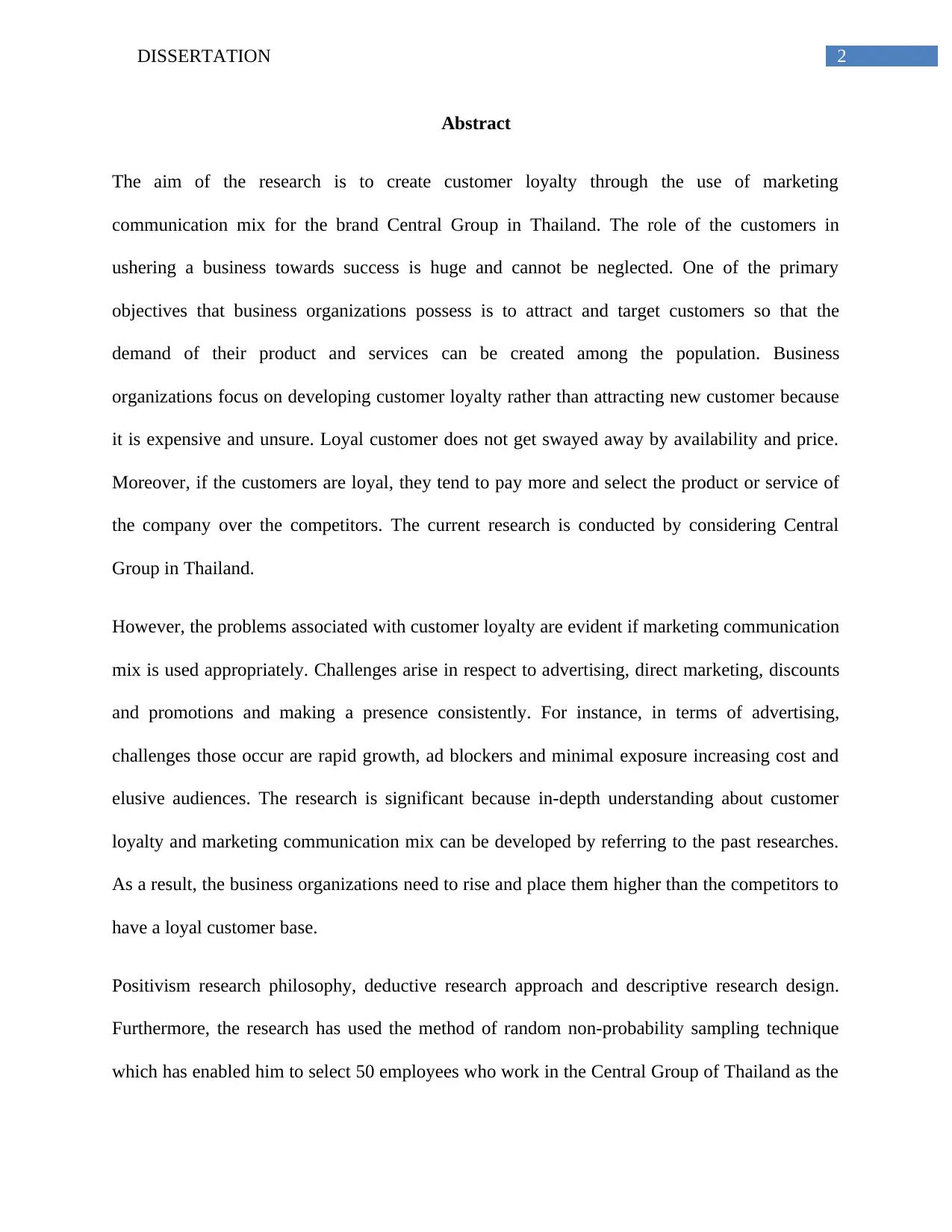
2DISSERTATION
Abstract
The aim of the research is to create customer loyalty through the use of marketing
communication mix for the brand Central Group in Thailand. The role of the customers in
ushering a business towards success is huge and cannot be neglected. One of the primary
objectives that business organizations possess is to attract and target customers so that the
demand of their product and services can be created among the population. Business
organizations focus on developing customer loyalty rather than attracting new customer because
it is expensive and unsure. Loyal customer does not get swayed away by availability and price.
Moreover, if the customers are loyal, they tend to pay more and select the product or service of
the company over the competitors. The current research is conducted by considering Central
Group in Thailand.
However, the problems associated with customer loyalty are evident if marketing communication
mix is used appropriately. Challenges arise in respect to advertising, direct marketing, discounts
and promotions and making a presence consistently. For instance, in terms of advertising,
challenges those occur are rapid growth, ad blockers and minimal exposure increasing cost and
elusive audiences. The research is significant because in-depth understanding about customer
loyalty and marketing communication mix can be developed by referring to the past researches.
As a result, the business organizations need to rise and place them higher than the competitors to
have a loyal customer base.
Positivism research philosophy, deductive research approach and descriptive research design.
Furthermore, the research has used the method of random non-probability sampling technique
which has enabled him to select 50 employees who work in the Central Group of Thailand as the
Abstract
The aim of the research is to create customer loyalty through the use of marketing
communication mix for the brand Central Group in Thailand. The role of the customers in
ushering a business towards success is huge and cannot be neglected. One of the primary
objectives that business organizations possess is to attract and target customers so that the
demand of their product and services can be created among the population. Business
organizations focus on developing customer loyalty rather than attracting new customer because
it is expensive and unsure. Loyal customer does not get swayed away by availability and price.
Moreover, if the customers are loyal, they tend to pay more and select the product or service of
the company over the competitors. The current research is conducted by considering Central
Group in Thailand.
However, the problems associated with customer loyalty are evident if marketing communication
mix is used appropriately. Challenges arise in respect to advertising, direct marketing, discounts
and promotions and making a presence consistently. For instance, in terms of advertising,
challenges those occur are rapid growth, ad blockers and minimal exposure increasing cost and
elusive audiences. The research is significant because in-depth understanding about customer
loyalty and marketing communication mix can be developed by referring to the past researches.
As a result, the business organizations need to rise and place them higher than the competitors to
have a loyal customer base.
Positivism research philosophy, deductive research approach and descriptive research design.
Furthermore, the research has used the method of random non-probability sampling technique
which has enabled him to select 50 employees who work in the Central Group of Thailand as the
⊘ This is a preview!⊘
Do you want full access?
Subscribe today to unlock all pages.

Trusted by 1+ million students worldwide
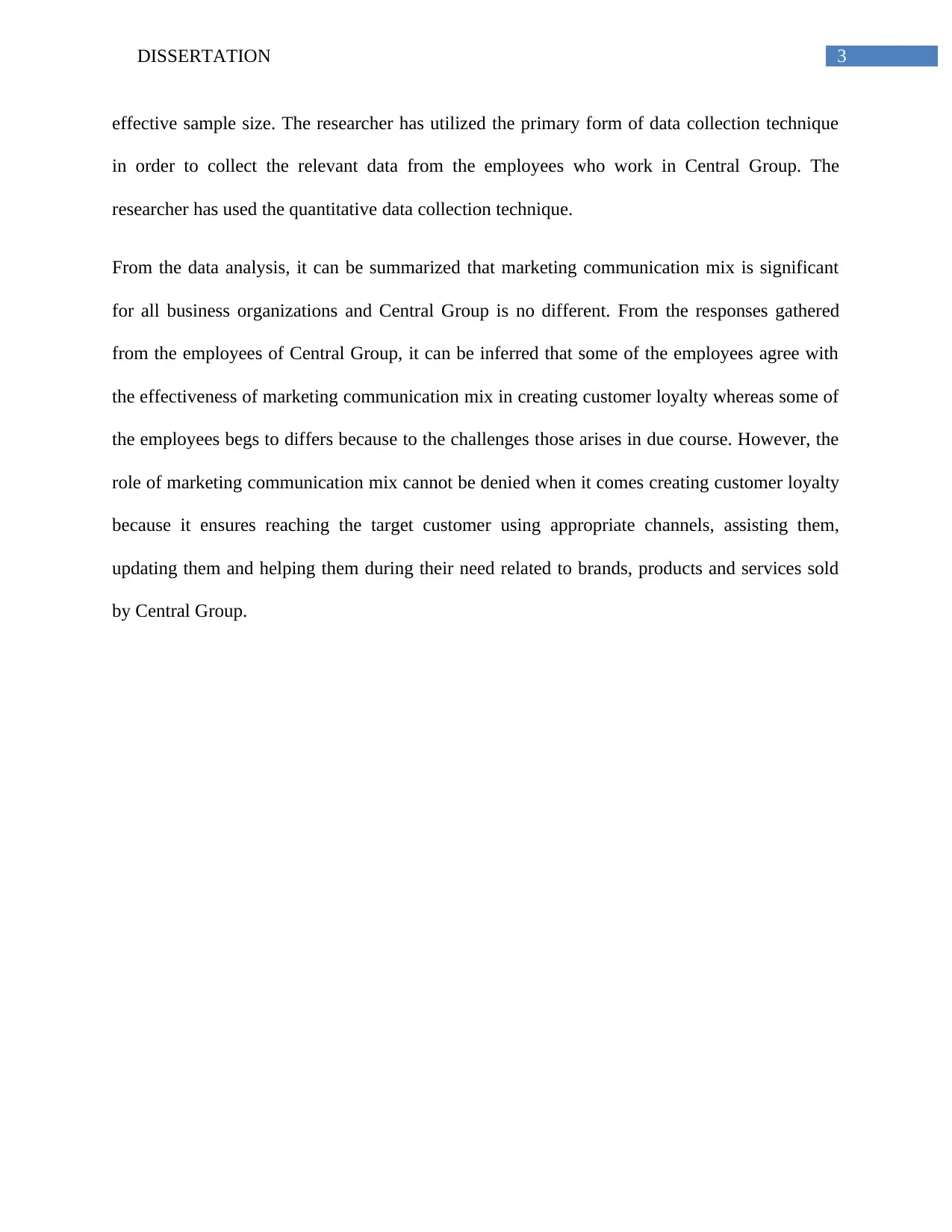
3DISSERTATION
effective sample size. The researcher has utilized the primary form of data collection technique
in order to collect the relevant data from the employees who work in Central Group. The
researcher has used the quantitative data collection technique.
From the data analysis, it can be summarized that marketing communication mix is significant
for all business organizations and Central Group is no different. From the responses gathered
from the employees of Central Group, it can be inferred that some of the employees agree with
the effectiveness of marketing communication mix in creating customer loyalty whereas some of
the employees begs to differs because to the challenges those arises in due course. However, the
role of marketing communication mix cannot be denied when it comes creating customer loyalty
because it ensures reaching the target customer using appropriate channels, assisting them,
updating them and helping them during their need related to brands, products and services sold
by Central Group.
effective sample size. The researcher has utilized the primary form of data collection technique
in order to collect the relevant data from the employees who work in Central Group. The
researcher has used the quantitative data collection technique.
From the data analysis, it can be summarized that marketing communication mix is significant
for all business organizations and Central Group is no different. From the responses gathered
from the employees of Central Group, it can be inferred that some of the employees agree with
the effectiveness of marketing communication mix in creating customer loyalty whereas some of
the employees begs to differs because to the challenges those arises in due course. However, the
role of marketing communication mix cannot be denied when it comes creating customer loyalty
because it ensures reaching the target customer using appropriate channels, assisting them,
updating them and helping them during their need related to brands, products and services sold
by Central Group.
Paraphrase This Document
Need a fresh take? Get an instant paraphrase of this document with our AI Paraphraser
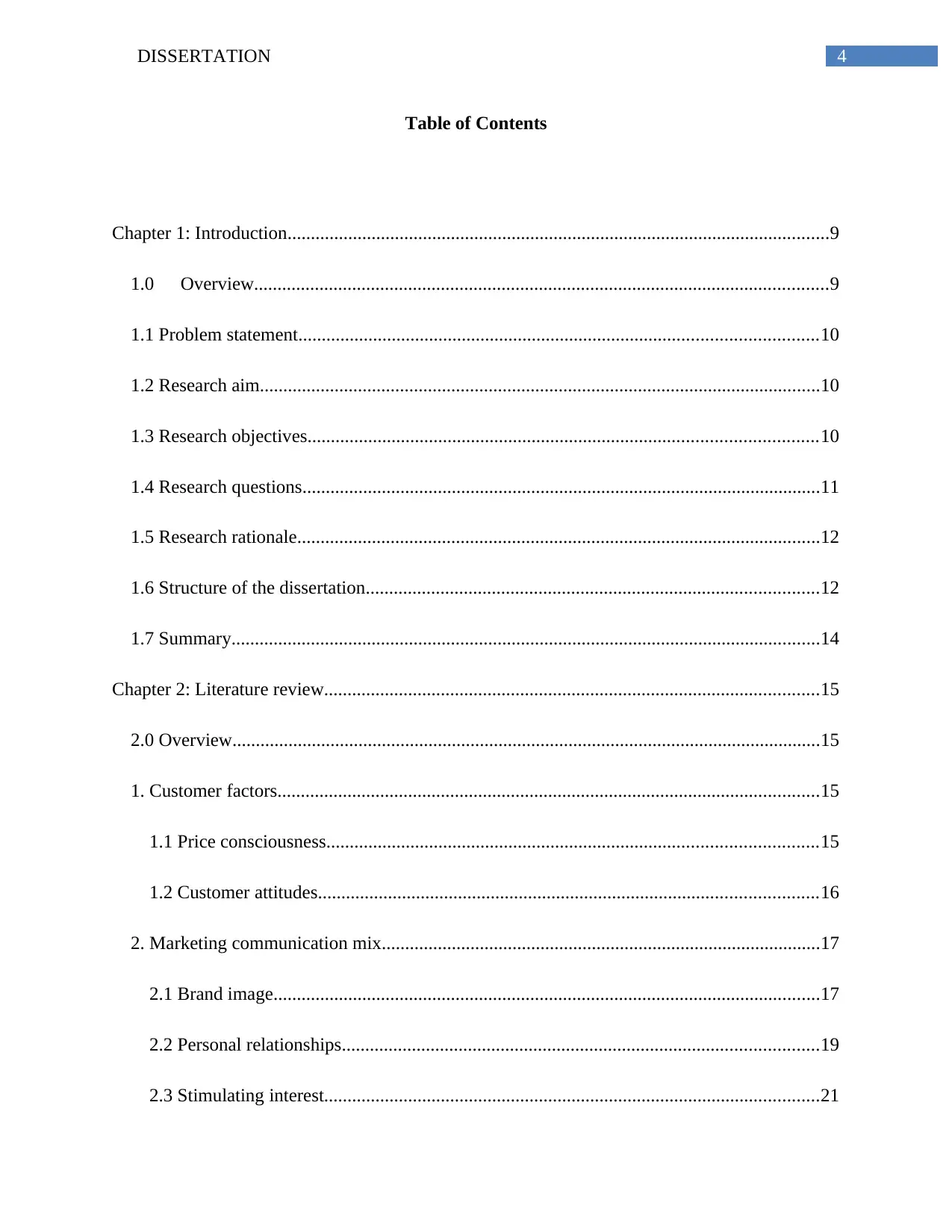
4DISSERTATION
Table of Contents
Chapter 1: Introduction....................................................................................................................9
1.0 Overview...........................................................................................................................9
1.1 Problem statement...............................................................................................................10
1.2 Research aim........................................................................................................................10
1.3 Research objectives.............................................................................................................10
1.4 Research questions...............................................................................................................11
1.5 Research rationale................................................................................................................12
1.6 Structure of the dissertation.................................................................................................12
1.7 Summary..............................................................................................................................14
Chapter 2: Literature review..........................................................................................................15
2.0 Overview..............................................................................................................................15
1. Customer factors....................................................................................................................15
1.1 Price consciousness.........................................................................................................15
1.2 Customer attitudes...........................................................................................................16
2. Marketing communication mix..............................................................................................17
2.1 Brand image.....................................................................................................................17
2.2 Personal relationships......................................................................................................19
2.3 Stimulating interest..........................................................................................................21
Table of Contents
Chapter 1: Introduction....................................................................................................................9
1.0 Overview...........................................................................................................................9
1.1 Problem statement...............................................................................................................10
1.2 Research aim........................................................................................................................10
1.3 Research objectives.............................................................................................................10
1.4 Research questions...............................................................................................................11
1.5 Research rationale................................................................................................................12
1.6 Structure of the dissertation.................................................................................................12
1.7 Summary..............................................................................................................................14
Chapter 2: Literature review..........................................................................................................15
2.0 Overview..............................................................................................................................15
1. Customer factors....................................................................................................................15
1.1 Price consciousness.........................................................................................................15
1.2 Customer attitudes...........................................................................................................16
2. Marketing communication mix..............................................................................................17
2.1 Brand image.....................................................................................................................17
2.2 Personal relationships......................................................................................................19
2.3 Stimulating interest..........................................................................................................21
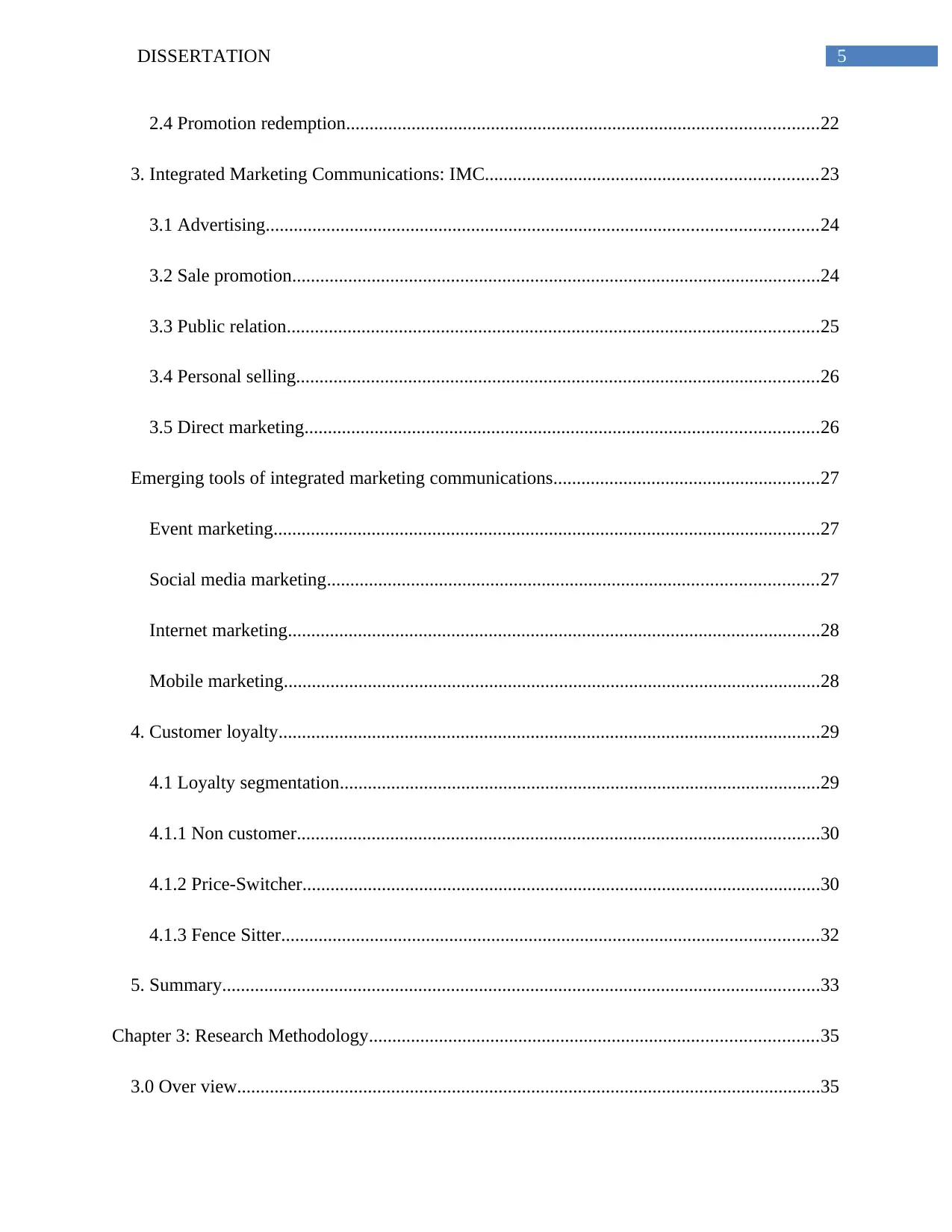
5DISSERTATION
2.4 Promotion redemption.....................................................................................................22
3. Integrated Marketing Communications: IMC.......................................................................23
3.1 Advertising......................................................................................................................24
3.2 Sale promotion.................................................................................................................24
3.3 Public relation..................................................................................................................25
3.4 Personal selling................................................................................................................26
3.5 Direct marketing..............................................................................................................26
Emerging tools of integrated marketing communications.........................................................27
Event marketing.....................................................................................................................27
Social media marketing.........................................................................................................27
Internet marketing..................................................................................................................28
Mobile marketing...................................................................................................................28
4. Customer loyalty....................................................................................................................29
4.1 Loyalty segmentation.......................................................................................................29
4.1.1 Non customer................................................................................................................30
4.1.2 Price-Switcher...............................................................................................................30
4.1.3 Fence Sitter...................................................................................................................32
5. Summary................................................................................................................................33
Chapter 3: Research Methodology................................................................................................35
3.0 Over view.............................................................................................................................35
2.4 Promotion redemption.....................................................................................................22
3. Integrated Marketing Communications: IMC.......................................................................23
3.1 Advertising......................................................................................................................24
3.2 Sale promotion.................................................................................................................24
3.3 Public relation..................................................................................................................25
3.4 Personal selling................................................................................................................26
3.5 Direct marketing..............................................................................................................26
Emerging tools of integrated marketing communications.........................................................27
Event marketing.....................................................................................................................27
Social media marketing.........................................................................................................27
Internet marketing..................................................................................................................28
Mobile marketing...................................................................................................................28
4. Customer loyalty....................................................................................................................29
4.1 Loyalty segmentation.......................................................................................................29
4.1.1 Non customer................................................................................................................30
4.1.2 Price-Switcher...............................................................................................................30
4.1.3 Fence Sitter...................................................................................................................32
5. Summary................................................................................................................................33
Chapter 3: Research Methodology................................................................................................35
3.0 Over view.............................................................................................................................35
⊘ This is a preview!⊘
Do you want full access?
Subscribe today to unlock all pages.

Trusted by 1+ million students worldwide
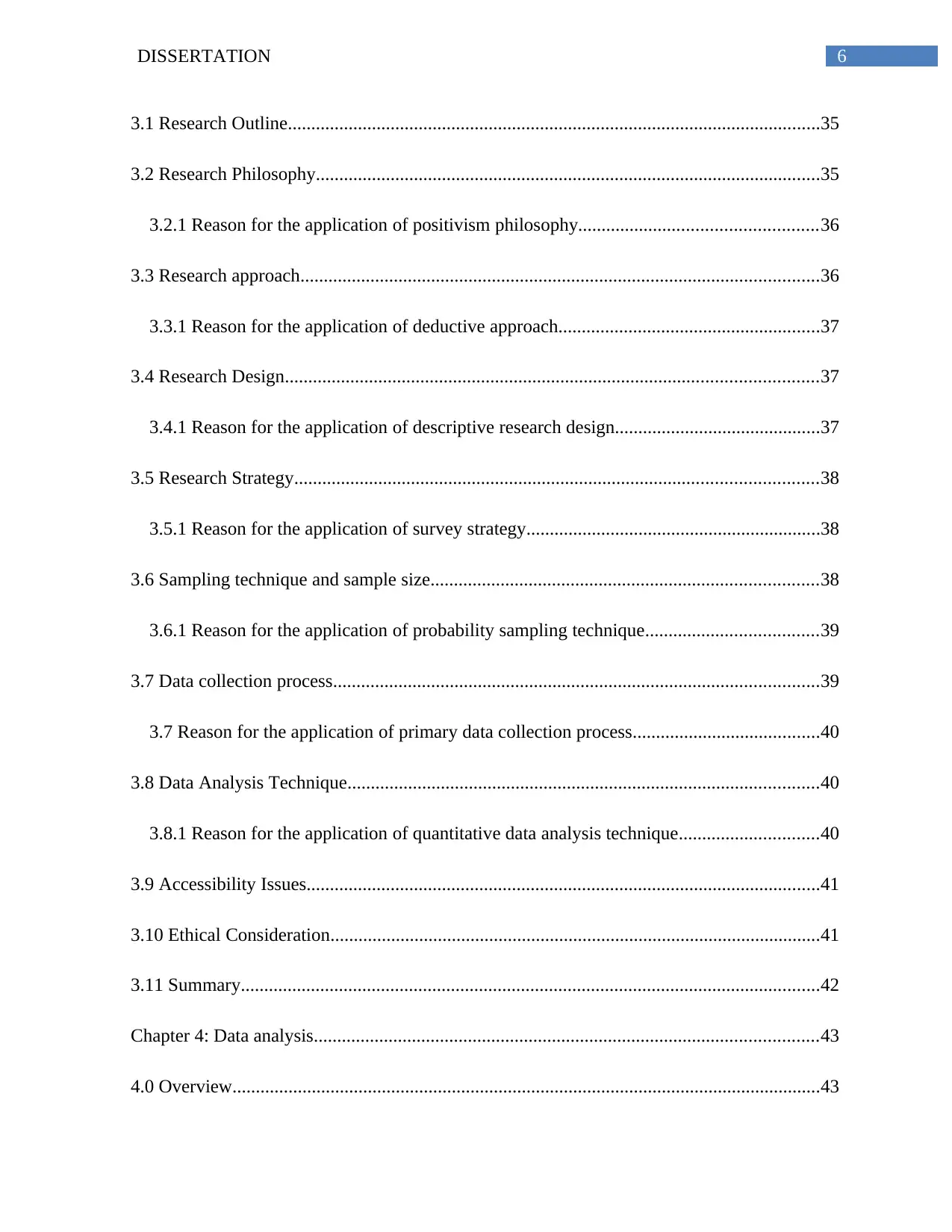
6DISSERTATION
3.1 Research Outline..................................................................................................................35
3.2 Research Philosophy............................................................................................................35
3.2.1 Reason for the application of positivism philosophy...................................................36
3.3 Research approach...............................................................................................................36
3.3.1 Reason for the application of deductive approach........................................................37
3.4 Research Design..................................................................................................................37
3.4.1 Reason for the application of descriptive research design............................................37
3.5 Research Strategy................................................................................................................38
3.5.1 Reason for the application of survey strategy...............................................................38
3.6 Sampling technique and sample size...................................................................................38
3.6.1 Reason for the application of probability sampling technique.....................................39
3.7 Data collection process........................................................................................................39
3.7 Reason for the application of primary data collection process........................................40
3.8 Data Analysis Technique.....................................................................................................40
3.8.1 Reason for the application of quantitative data analysis technique..............................40
3.9 Accessibility Issues..............................................................................................................41
3.10 Ethical Consideration.........................................................................................................41
3.11 Summary............................................................................................................................42
Chapter 4: Data analysis............................................................................................................43
4.0 Overview..............................................................................................................................43
3.1 Research Outline..................................................................................................................35
3.2 Research Philosophy............................................................................................................35
3.2.1 Reason for the application of positivism philosophy...................................................36
3.3 Research approach...............................................................................................................36
3.3.1 Reason for the application of deductive approach........................................................37
3.4 Research Design..................................................................................................................37
3.4.1 Reason for the application of descriptive research design............................................37
3.5 Research Strategy................................................................................................................38
3.5.1 Reason for the application of survey strategy...............................................................38
3.6 Sampling technique and sample size...................................................................................38
3.6.1 Reason for the application of probability sampling technique.....................................39
3.7 Data collection process........................................................................................................39
3.7 Reason for the application of primary data collection process........................................40
3.8 Data Analysis Technique.....................................................................................................40
3.8.1 Reason for the application of quantitative data analysis technique..............................40
3.9 Accessibility Issues..............................................................................................................41
3.10 Ethical Consideration.........................................................................................................41
3.11 Summary............................................................................................................................42
Chapter 4: Data analysis............................................................................................................43
4.0 Overview..............................................................................................................................43
Paraphrase This Document
Need a fresh take? Get an instant paraphrase of this document with our AI Paraphraser
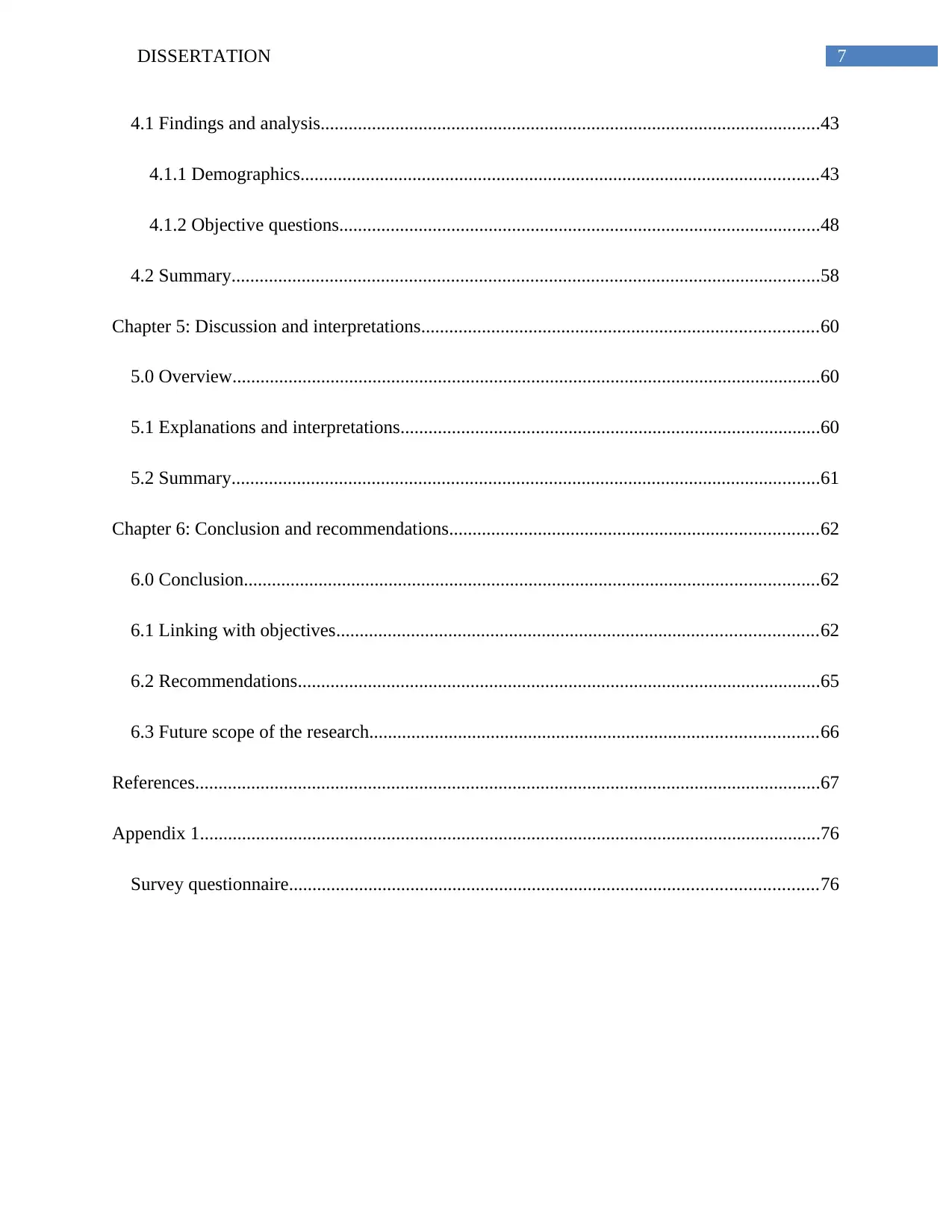
7DISSERTATION
4.1 Findings and analysis...........................................................................................................43
4.1.1 Demographics...............................................................................................................43
4.1.2 Objective questions.......................................................................................................48
4.2 Summary..............................................................................................................................58
Chapter 5: Discussion and interpretations.....................................................................................60
5.0 Overview..............................................................................................................................60
5.1 Explanations and interpretations..........................................................................................60
5.2 Summary..............................................................................................................................61
Chapter 6: Conclusion and recommendations...............................................................................62
6.0 Conclusion...........................................................................................................................62
6.1 Linking with objectives.......................................................................................................62
6.2 Recommendations................................................................................................................65
6.3 Future scope of the research................................................................................................66
References......................................................................................................................................67
Appendix 1.....................................................................................................................................76
Survey questionnaire.................................................................................................................76
4.1 Findings and analysis...........................................................................................................43
4.1.1 Demographics...............................................................................................................43
4.1.2 Objective questions.......................................................................................................48
4.2 Summary..............................................................................................................................58
Chapter 5: Discussion and interpretations.....................................................................................60
5.0 Overview..............................................................................................................................60
5.1 Explanations and interpretations..........................................................................................60
5.2 Summary..............................................................................................................................61
Chapter 6: Conclusion and recommendations...............................................................................62
6.0 Conclusion...........................................................................................................................62
6.1 Linking with objectives.......................................................................................................62
6.2 Recommendations................................................................................................................65
6.3 Future scope of the research................................................................................................66
References......................................................................................................................................67
Appendix 1.....................................................................................................................................76
Survey questionnaire.................................................................................................................76
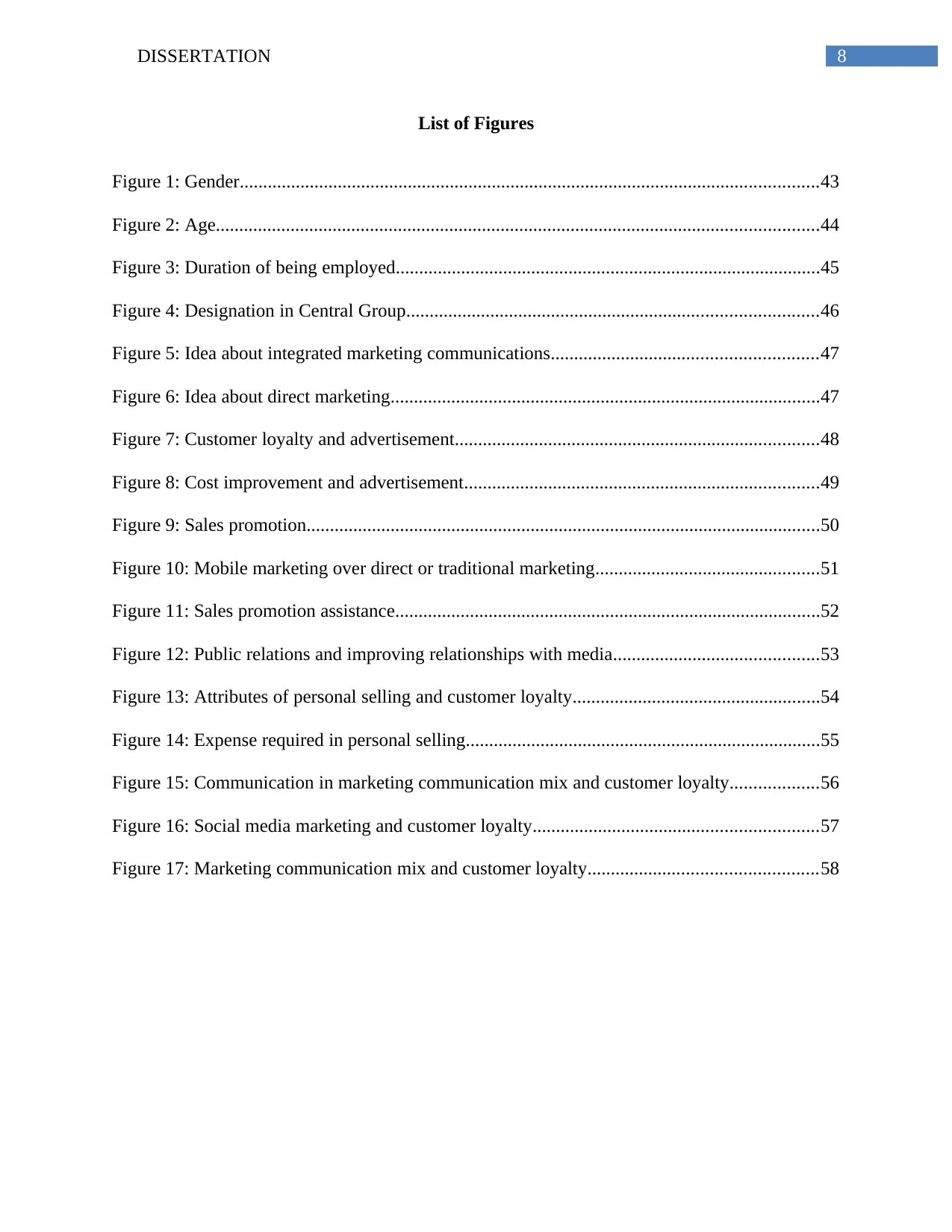
8DISSERTATION
List of Figures
Figure 1: Gender............................................................................................................................43
Figure 2: Age.................................................................................................................................44
Figure 3: Duration of being employed...........................................................................................45
Figure 4: Designation in Central Group........................................................................................46
Figure 5: Idea about integrated marketing communications.........................................................47
Figure 6: Idea about direct marketing............................................................................................47
Figure 7: Customer loyalty and advertisement..............................................................................48
Figure 8: Cost improvement and advertisement............................................................................49
Figure 9: Sales promotion..............................................................................................................50
Figure 10: Mobile marketing over direct or traditional marketing................................................51
Figure 11: Sales promotion assistance...........................................................................................52
Figure 12: Public relations and improving relationships with media............................................53
Figure 13: Attributes of personal selling and customer loyalty.....................................................54
Figure 14: Expense required in personal selling............................................................................55
Figure 15: Communication in marketing communication mix and customer loyalty...................56
Figure 16: Social media marketing and customer loyalty.............................................................57
Figure 17: Marketing communication mix and customer loyalty.................................................58
List of Figures
Figure 1: Gender............................................................................................................................43
Figure 2: Age.................................................................................................................................44
Figure 3: Duration of being employed...........................................................................................45
Figure 4: Designation in Central Group........................................................................................46
Figure 5: Idea about integrated marketing communications.........................................................47
Figure 6: Idea about direct marketing............................................................................................47
Figure 7: Customer loyalty and advertisement..............................................................................48
Figure 8: Cost improvement and advertisement............................................................................49
Figure 9: Sales promotion..............................................................................................................50
Figure 10: Mobile marketing over direct or traditional marketing................................................51
Figure 11: Sales promotion assistance...........................................................................................52
Figure 12: Public relations and improving relationships with media............................................53
Figure 13: Attributes of personal selling and customer loyalty.....................................................54
Figure 14: Expense required in personal selling............................................................................55
Figure 15: Communication in marketing communication mix and customer loyalty...................56
Figure 16: Social media marketing and customer loyalty.............................................................57
Figure 17: Marketing communication mix and customer loyalty.................................................58
⊘ This is a preview!⊘
Do you want full access?
Subscribe today to unlock all pages.

Trusted by 1+ million students worldwide
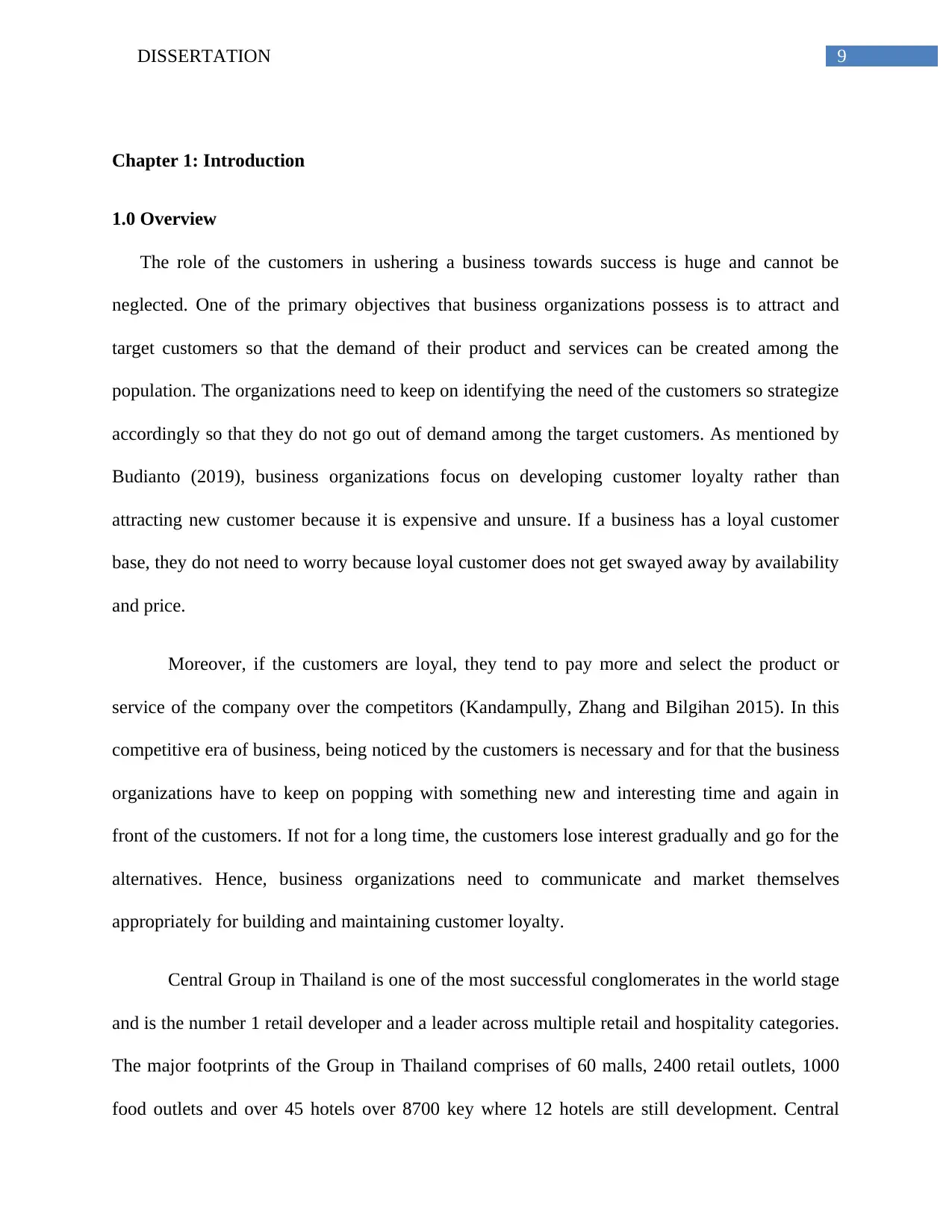
9DISSERTATION
Chapter 1: Introduction
1.0 Overview
The role of the customers in ushering a business towards success is huge and cannot be
neglected. One of the primary objectives that business organizations possess is to attract and
target customers so that the demand of their product and services can be created among the
population. The organizations need to keep on identifying the need of the customers so strategize
accordingly so that they do not go out of demand among the target customers. As mentioned by
Budianto (2019), business organizations focus on developing customer loyalty rather than
attracting new customer because it is expensive and unsure. If a business has a loyal customer
base, they do not need to worry because loyal customer does not get swayed away by availability
and price.
Moreover, if the customers are loyal, they tend to pay more and select the product or
service of the company over the competitors (Kandampully, Zhang and Bilgihan 2015). In this
competitive era of business, being noticed by the customers is necessary and for that the business
organizations have to keep on popping with something new and interesting time and again in
front of the customers. If not for a long time, the customers lose interest gradually and go for the
alternatives. Hence, business organizations need to communicate and market themselves
appropriately for building and maintaining customer loyalty.
Central Group in Thailand is one of the most successful conglomerates in the world stage
and is the number 1 retail developer and a leader across multiple retail and hospitality categories.
The major footprints of the Group in Thailand comprises of 60 malls, 2400 retail outlets, 1000
food outlets and over 45 hotels over 8700 key where 12 hotels are still development. Central
Chapter 1: Introduction
1.0 Overview
The role of the customers in ushering a business towards success is huge and cannot be
neglected. One of the primary objectives that business organizations possess is to attract and
target customers so that the demand of their product and services can be created among the
population. The organizations need to keep on identifying the need of the customers so strategize
accordingly so that they do not go out of demand among the target customers. As mentioned by
Budianto (2019), business organizations focus on developing customer loyalty rather than
attracting new customer because it is expensive and unsure. If a business has a loyal customer
base, they do not need to worry because loyal customer does not get swayed away by availability
and price.
Moreover, if the customers are loyal, they tend to pay more and select the product or
service of the company over the competitors (Kandampully, Zhang and Bilgihan 2015). In this
competitive era of business, being noticed by the customers is necessary and for that the business
organizations have to keep on popping with something new and interesting time and again in
front of the customers. If not for a long time, the customers lose interest gradually and go for the
alternatives. Hence, business organizations need to communicate and market themselves
appropriately for building and maintaining customer loyalty.
Central Group in Thailand is one of the most successful conglomerates in the world stage
and is the number 1 retail developer and a leader across multiple retail and hospitality categories.
The major footprints of the Group in Thailand comprises of 60 malls, 2400 retail outlets, 1000
food outlets and over 45 hotels over 8700 key where 12 hotels are still development. Central
Paraphrase This Document
Need a fresh take? Get an instant paraphrase of this document with our AI Paraphraser
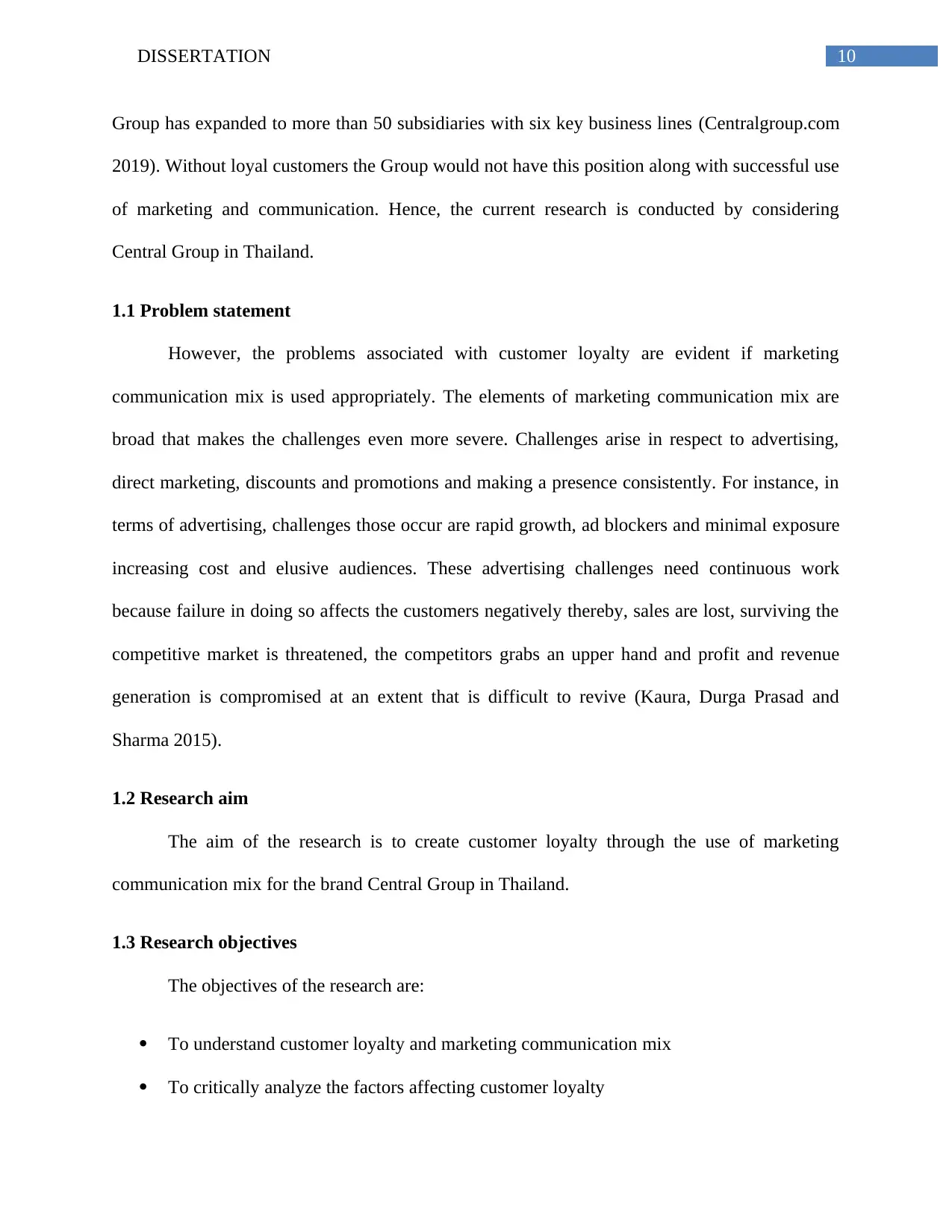
10DISSERTATION
Group has expanded to more than 50 subsidiaries with six key business lines (Centralgroup.com
2019). Without loyal customers the Group would not have this position along with successful use
of marketing and communication. Hence, the current research is conducted by considering
Central Group in Thailand.
1.1 Problem statement
However, the problems associated with customer loyalty are evident if marketing
communication mix is used appropriately. The elements of marketing communication mix are
broad that makes the challenges even more severe. Challenges arise in respect to advertising,
direct marketing, discounts and promotions and making a presence consistently. For instance, in
terms of advertising, challenges those occur are rapid growth, ad blockers and minimal exposure
increasing cost and elusive audiences. These advertising challenges need continuous work
because failure in doing so affects the customers negatively thereby, sales are lost, surviving the
competitive market is threatened, the competitors grabs an upper hand and profit and revenue
generation is compromised at an extent that is difficult to revive (Kaura, Durga Prasad and
Sharma 2015).
1.2 Research aim
The aim of the research is to create customer loyalty through the use of marketing
communication mix for the brand Central Group in Thailand.
1.3 Research objectives
The objectives of the research are:
To understand customer loyalty and marketing communication mix
To critically analyze the factors affecting customer loyalty
Group has expanded to more than 50 subsidiaries with six key business lines (Centralgroup.com
2019). Without loyal customers the Group would not have this position along with successful use
of marketing and communication. Hence, the current research is conducted by considering
Central Group in Thailand.
1.1 Problem statement
However, the problems associated with customer loyalty are evident if marketing
communication mix is used appropriately. The elements of marketing communication mix are
broad that makes the challenges even more severe. Challenges arise in respect to advertising,
direct marketing, discounts and promotions and making a presence consistently. For instance, in
terms of advertising, challenges those occur are rapid growth, ad blockers and minimal exposure
increasing cost and elusive audiences. These advertising challenges need continuous work
because failure in doing so affects the customers negatively thereby, sales are lost, surviving the
competitive market is threatened, the competitors grabs an upper hand and profit and revenue
generation is compromised at an extent that is difficult to revive (Kaura, Durga Prasad and
Sharma 2015).
1.2 Research aim
The aim of the research is to create customer loyalty through the use of marketing
communication mix for the brand Central Group in Thailand.
1.3 Research objectives
The objectives of the research are:
To understand customer loyalty and marketing communication mix
To critically analyze the factors affecting customer loyalty
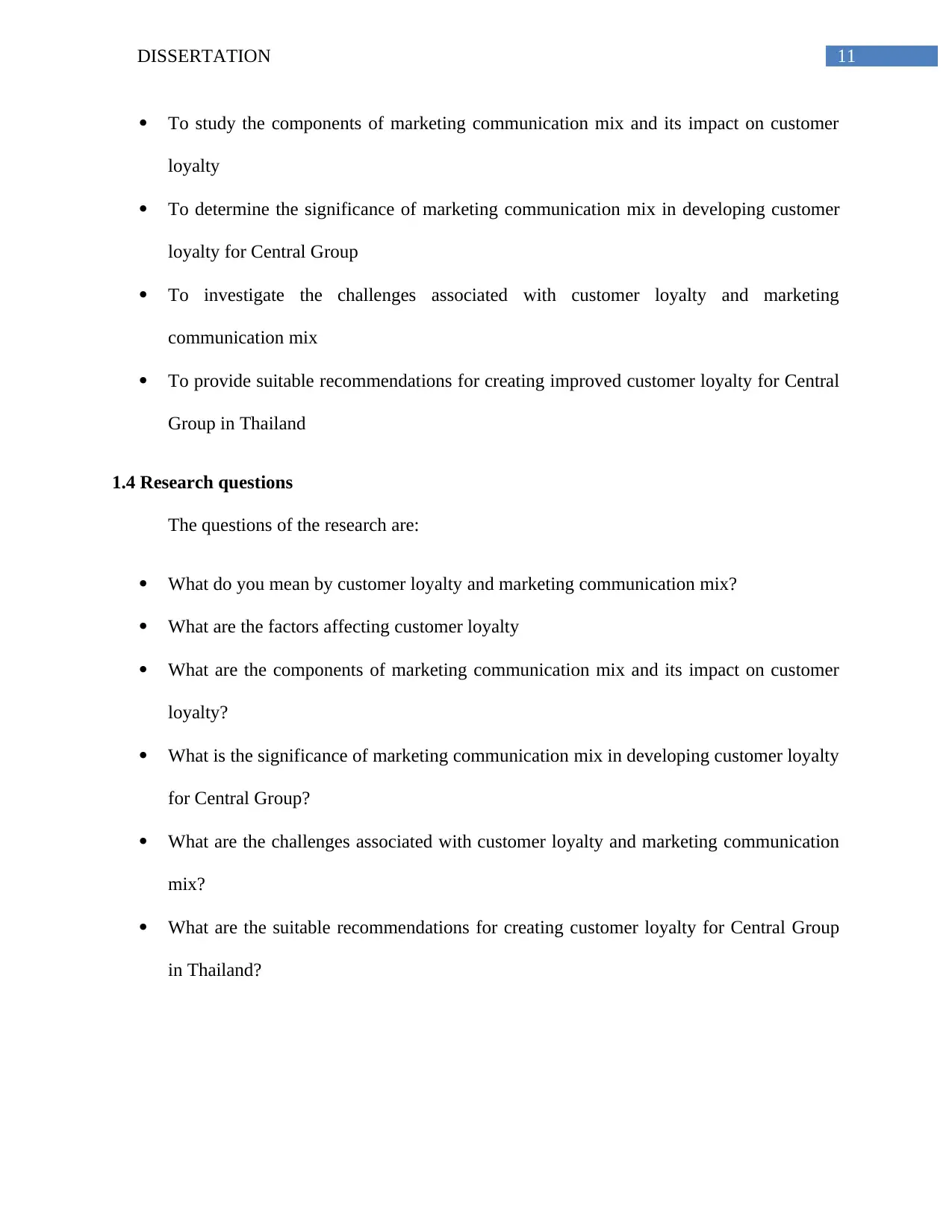
11DISSERTATION
To study the components of marketing communication mix and its impact on customer
loyalty
To determine the significance of marketing communication mix in developing customer
loyalty for Central Group
To investigate the challenges associated with customer loyalty and marketing
communication mix
To provide suitable recommendations for creating improved customer loyalty for Central
Group in Thailand
1.4 Research questions
The questions of the research are:
What do you mean by customer loyalty and marketing communication mix?
What are the factors affecting customer loyalty
What are the components of marketing communication mix and its impact on customer
loyalty?
What is the significance of marketing communication mix in developing customer loyalty
for Central Group?
What are the challenges associated with customer loyalty and marketing communication
mix?
What are the suitable recommendations for creating customer loyalty for Central Group
in Thailand?
To study the components of marketing communication mix and its impact on customer
loyalty
To determine the significance of marketing communication mix in developing customer
loyalty for Central Group
To investigate the challenges associated with customer loyalty and marketing
communication mix
To provide suitable recommendations for creating improved customer loyalty for Central
Group in Thailand
1.4 Research questions
The questions of the research are:
What do you mean by customer loyalty and marketing communication mix?
What are the factors affecting customer loyalty
What are the components of marketing communication mix and its impact on customer
loyalty?
What is the significance of marketing communication mix in developing customer loyalty
for Central Group?
What are the challenges associated with customer loyalty and marketing communication
mix?
What are the suitable recommendations for creating customer loyalty for Central Group
in Thailand?
⊘ This is a preview!⊘
Do you want full access?
Subscribe today to unlock all pages.

Trusted by 1+ million students worldwide
1 out of 82
Related Documents
Your All-in-One AI-Powered Toolkit for Academic Success.
+13062052269
info@desklib.com
Available 24*7 on WhatsApp / Email
![[object Object]](/_next/static/media/star-bottom.7253800d.svg)
Unlock your academic potential
Copyright © 2020–2025 A2Z Services. All Rights Reserved. Developed and managed by ZUCOL.





